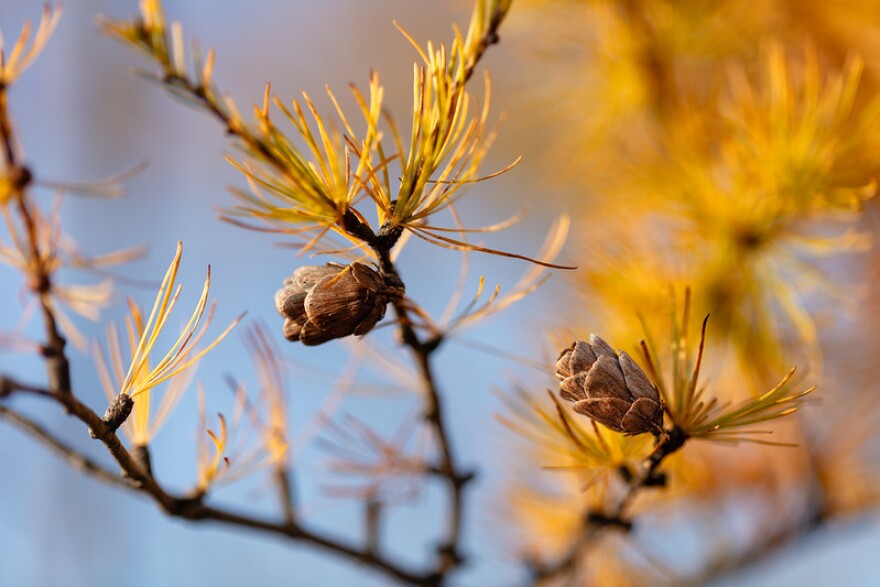GRAND RAPIDS — “It’s time for the Phenology show. Wow, how many times have I said that?” Staff Phenologist John Latimer asked Tuesday, Nov. 14.
(Over 2,000 times, according to my rapid calculations!)
Leafy things
John jokes he could pull a tape from November 1983 and his show would still be pretty much the same — it’s a slow time of year for phenology.
Currently, John's eye has been drawn to the few remaining leafy things in the woods and along the roads. They’re mostly non-native species, such as the weeping willow, Lombardy poplar and cottonwood. The freezing weather has killed off most of the leaves, leaving them dark brown and rapidly falling from the branches. The weeping willow sheds many branches and twigs in the fall.
“They make up for their messiness by giving us this beautiful springtime color,” John says.
These trees will be one of the first plants to brighten up in spring, with the tips of their branches turning a lovely neon yellow.
Unless planted, cottonwood trees don’t typically grow as far north as Grand Rapids. However, they’re a common sight around mines, where they were planted due to their rapid growth.
In the forest understory, you’ll find a smaller tree that still has a number of orange-brown leaves. This is the ironwood plant, prized for its exceptionally strong, hard wood. While older individuals may lose more of their leaves, younger trees hold most of their crown until new growth emerges in the spring.
Tamaracks and larches
In the swamps, tamarack trees are holding on to the last of their needles.
“The tamaracks at my house are this kind of ghostly yellow. There’s maybe 5 to 10% of their needles left on the trees, and they are absolutely at the end of their color phase.”

The only stage left for the tamaracks this year is to lose all their needles except the newest growth at the tips of the branches. These needles grow singly, instead of the clumps you’ll see on older growth. (Older nodes may have 15-20 needles emerging from a single spot.)
If you’re driving by a tamarack that looks like it forgot to shed its needles for the winter, you’re likely looking at a European larch. These are cousins of the tamarack, but their seasonal responses are different. John is particularly fond of this tree, as his dad planted one in the yard at John’s childhood home.
“I used to love it, because it just had these big drooping branches and it was so late in the fall that it changed color. It was just one of my favorite trees.”
John has been considering planting a new one, since the original tree was attacked by larch beetles and died a number of years ago.
We’ll be celebrating 40 Years of Phenology at 6 p.m. Saturday, Nov. 18, at Klockow Brewing Co.
Please join us: attendance is free and all are welcome. If you’d like to express your appreciation for John and his work – and I encourage you to do so - please send your note/remarks to me, Charlie Mitchell, at cmitchell@kaxe.org.
I can’t wait to celebrate the old fella with all of you!
Species spotlight
Blueberry leaves were red last week, but have dropped since last week’s report. John is still able to spot some green plants in the forest, such as hepatica and the rock polypody, but color is harder to find in the woods these days!
John was happy to see a few white fluffs of milkweed seeds float past his window over the last week, however.
Canada Geese are flying past in huge flocks. John saw one so large he gave up counting after reaching 100! Each arm of the V-shaped formation was nearly a quarter-mile long.
John has seen two Red-bellied Woodpeckers come to his feeder. He’s not quite sure if one of them is the juvenile that was a frequent visitor earlier in the fall, but he suspects it is — it has just a little less red on the head.
Gratitude
With his trademark humor, John concludes, “That’s the Phenology show for this week, and thank you for listening. Thanks to some of you for listening for 40 years! Holy mackerel. I would have thought by now you would have figured it all out: you wouldn’t need the show. But oh well, hey, come back again next week! I’ll think of something to say.”
That does it for this week! For more phenology, <b class="rte2-style-bold">subscribe</b> to our Season Watch Newsletter or visit the Season Watch Facebook page.
Funding for this project was provided by the Minnesota Environment and Natural Resources Trust Fund as recommended by the Legislative-Citizen Commission on Minnesota Resources (LCCMR).








